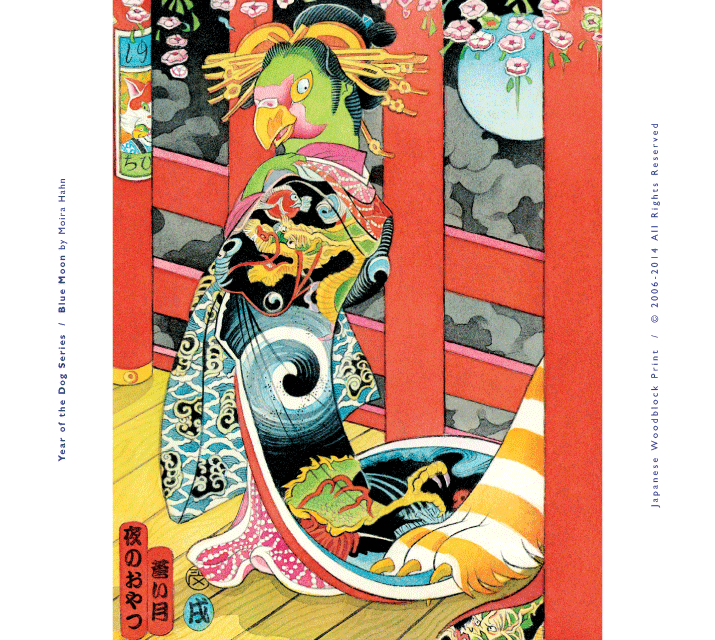Moira Hahn: East Meets West in Vibrant, Satirical Paintings
On a brisk fall day in the early 1960s, Moira Hahn’s mother sent her out into their suburban Maryland yard to clear leaves from a patio. Rather than gather the scattered vegetation for disposal, the 7-year-old saw something completely different within the pile of nature’s bounty before her. When Hahn finished with her “chore,” the budding artist had raked the leaves into the shape of a hatted cowboy on a horse. Connecting decidedly different or even conflicting elements to create a compelling piece of art is the hallmark of this Long Beach artist, who has exhibited throughout the U.S. and Japan for more than 20 years. Bold and colorful, her paintings, which walk a tightrope between Western and Eastern themes and the past and present, elicit admiration, surprise, and more often than not a chuckle once a painting’s often satirical message becomes apparent. While some have described Hahn’s paintings as “Pop-Surrealism,” she doesn’t find this an accurate description of her work, which has its roots in classical Japanese art history—specifically Ukiyo-e (pictures of the floating world). The genre features woodblock prints and paintings popular from 17th–19th century Japan. “Nouveau Ukiyo-e might cover some of my work, because it contains elements from the contemporary and floating worlds,” says Hahn, who taught art at Santiago Canyon College for 10 years. Many of her paintings depict humanlike interactions regarding present-day topics between animals dressed in ancient Japanese kimono styles.Born to Paint
Hahn has always gravitated to art. Throughout her childhood, she constantly created using materials she found on hand. Nature was—and continues to be—an artistic muse for her.- She made tea sets out of backyard clay.
- In high school, she spent afternoons in the forest observing wildlife such as deer, badgers, and foxes.
- She gathered plant materials for her artwork, including walnut shells she boiled to make brown ink.
- BFA from MICA in 1977
- Additional studies at CalArts in Valencia
- MFA from California State University Fullerton in 2000
Asian Influence
Though it might seem unusual that a non-Asian artist would be interested in Ukiyo-e, it was a natural progression for Hahn, who comes from a family of artists and art appreciators.- Her father served in China during WWII and collected cloisonné and local crafts.
- An uncle stationed in Japan in the 1960s sent back art to the family.
- Her parents built a Japanese-style cedar house with Japanese furniture.
Blue Moon
 The painting “Blue Moon”, pictured above, exemplifies Hahn’s east-meets-west style.
A parrot seductively poses in a kimono while a large cat paw rests on the tail of her garment.
At first glance, the parrot appears to be in danger.
The painting “Blue Moon”, pictured above, exemplifies Hahn’s east-meets-west style.
A parrot seductively poses in a kimono while a large cat paw rests on the tail of her garment.
At first glance, the parrot appears to be in danger.
“People worry about the parrot, but she’s fine,” says Hahn. “The birds hung up posters all over the neighborhood of the cats they intend to pick off.” (The parrot has an AK-47 hidden under her kimono.)Art historian Meher McArthur, who has curated shows featuring Hahn’s work, adds:
“Moira is superb with the brush and has a wonderful sense of color. Her work is layered and rich. At first glance, the animals in her paintings appear to be cute, but then you realize something unsettling is occurring. The parrot in ‘Blue Moon’ is dressed like a 19th-century courtesan and is exposing the nape of her neck, which was considered very seductive. The subtitle of the painting (written in Japanese) is also compelling and amusing—‘Evening Snack.’”In 2010, Hahn added to her collection a traditional woodblock print of “Blue Moon.” Crafted in Japan, it took a team—including a carver and an inker— more than a year to produce a limited edition of 200. “Having the print made was on my bucket list,” says Hahn. “It turned out beautifully.”
Explore More of Moira Hahn’s Work
Visit her portfolio and galleries online: Beginning March 22nd, Hahn will teach a watercolor technique class series at The Art Studio in Westminster. Learn more at theartstudio.us/place/watercolor.Published in the Mar/Apr 2014 edition of the Old Towne Orange Plaza Review
Written by Julie Bawden-Davis, Photograph provided by Moira Hahn

